Nepenthes, Kantong Semar - Tropical pitcher plant
N. tobaika, N. sumatrana, N. naga, N. mikei, N. jamban, N. inermis, N. eustachya, N. bongso, N. mirabiis, N. adnata
Kantong semar - Tropical pitcher plant
Nepenthes
R. rochussenii, R. patma, R. micropylora, R. borneensis, R. arnoldii, R. zollingeriana Kds
 Kantong Semar, Nepenthes (/nɪˈpɛnθiːz/) is a genus of carnivorous plants, also known as tropical pitcher plants, or monkey cups, in the monotypic family Nepenthaceae. The genus includes 170 species, and numerous natural and many cultivated hybrids. They are mostly liana-forming plants of the Old World tropics, ranging from South China, Indonesia, Malaysia, and the Philippines; westward to Madagascar (two species) and the Seychelles (one); southward to Australia (four) and New Caledonia (one); and northward to India (one) and Sri Lanka (one).
Kantong Semar, Nepenthes (/nɪˈpɛnθiːz/) is a genus of carnivorous plants, also known as tropical pitcher plants, or monkey cups, in the monotypic family Nepenthaceae. The genus includes 170 species, and numerous natural and many cultivated hybrids. They are mostly liana-forming plants of the Old World tropics, ranging from South China, Indonesia, Malaysia, and the Philippines; westward to Madagascar (two species) and the Seychelles (one); southward to Australia (four) and New Caledonia (one); and northward to India (one) and Sri Lanka (one).
The greatest diversity occurs on Borneo, Sumatra, and the Philippines, with many endemic species. Many are plants of hot, humid, lowland areas, but the majority are tropical montane plants, receiving warm days but cool to cold, humid nights year round. A few are considered tropical alpine, with cool days and nights near freezing. The name “monkey cups” refers to the fact that monkeys were once thought to drink rainwater from the pitchers.
Nepenthes species usually consist of a shallow root system and a prostrate or climbing stem, often several metres long and up to 15 m (49 ft) or more, and usually 1 cm (0.4 in) or less in diameter, although this may be thicker in a few species (e.g. N. bicalcarata). From the stems arise alternate, sword-shaped leaves with entire leaf margins. An extension of the midrib (the tendril), which in some species aids in climbing, protrudes from the tip of the leaf; at the end of the tendril the pitcher forms. The pitcher starts as a small bud and gradually expands to form a globe- or tube-shaped trap. The shapes can evoke a champagne flute or a condom.
The trap contains a fluid of the plant’s own production, which may be watery or more viscous, and is used to drown the prey. This fluid contains viscoelastic biopolymers that may be crucial to the retention of insects within the traps of many species. The viscoelastic fluid in pitchers is especially effective in the retention of winged insects. The trapping efficiency of this fluid remains high, even when significantly diluted by water, as inevitably happens in wet conditions.
The lower part of the trap contains glands which absorb nutrients from captured prey. Along the upper inside part of the trap is a slick, waxy coating which makes the escape of its prey nearly impossible. Surrounding the entrance to the trap is a structure called the peristome (the “lip”), which is slippery and often quite colorful, attracting prey, but offering an unsure footing. The prey-capture effectiveness of the peristome is further enhanced in moist environments, where condensation may cause a thin water film to form on the surface of the peristome. When wet, the slippery surface of the peristome causes insects to ‘aquaplane’, or slip and fall, into the pitcher. Above the peristome is a lid (the operculum); in many species, this keeps rain from diluting the fluid within the pitcher, the underside of which may contain nectar glands which attract prey.
Nepenthes species usually produce two types of pitchers, known as leaf dimorphism. Appearing near the base of the plant are the large, lower traps, which typically sit on the ground. The upper or aerial pitchers are usually smaller, coloured differently, and possess different features from the lower pitchers. These upper pitchers usually form as the plant reaches maturity and the plant grows taller. To keep the plant steady, the upper pitchers often form a loop in the tendril, allowing it to wrap around nearby support. In some species (e.g. N. rafflesiana), different prey may be attracted by the two types of pitchers. This varied morphology also often makes identification of species difficult.
Prey usually consists of insects, but the largest species (e.g. N. rajah and N. rafflesiana) may occasionally catch small vertebrates, such as rats and lizards. Records of cultivated plants trapping small birds have been made. Flowers occur in racemes or more rarely in panicles with male and female flowers on separate plants. Three species have symbiotic relationships with tree shrews, which eat the nectar produced by the plant and defecate into the pitchers, providing valuable nutrients.
Nepenthes are insect-pollinated, the primary agents being flies (including blow flies, midges, and mosquitoes), moths, wasps, and butterflies. Their smells can range from sweet to musty or fungus-like. Seed is typically produced in a four-sided capsule which may contain 50–500 wind-distributed seeds, consisting of a central embryo and two wings, one on either side (though N. pervillei differs).
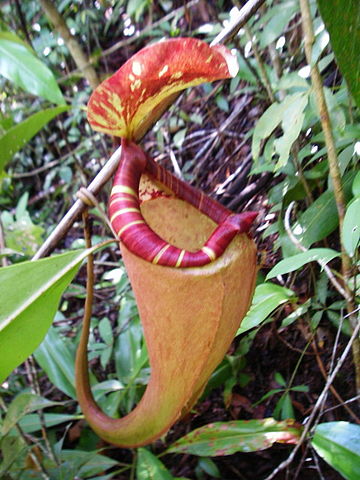 Etymology
Etymology
The genus name Nepenthes was first published in 1737 in Carl Linnaeus’s Hortus Cliffortianus. It references a passage in Homer’s Odyssey, in which the potion “Nepenthes pharmakon” is given to Helen by an Egyptian queen. “Nepenthe” literally means “without grief” (ne = not, penthos = grief) and, in Greek mythology, is a drug that quells all sorrows with forgetfulness.
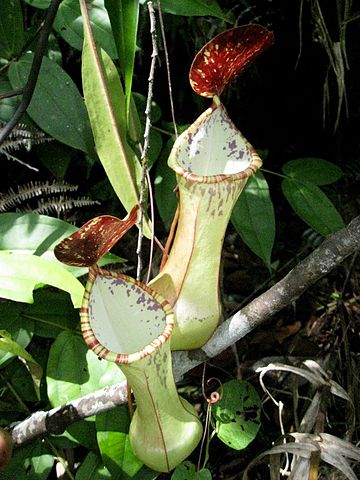 Nepenthes was formally published as a generic name in 1753 in Linnaeus’s famous Species Plantarum, which established botanical nomenclature as it exists today. Nepenthes distillatoria is the type species of the genus. The name “monkey cups” was discussed in the May 1964 issue of National Geographic.
The plants are often called kantong semar (Semar’s pocket) in Indonesia and sako ni Hudas (Judas’ money bag) in the Philippines.
Nepenthes was formally published as a generic name in 1753 in Linnaeus’s famous Species Plantarum, which established botanical nomenclature as it exists today. Nepenthes distillatoria is the type species of the genus. The name “monkey cups” was discussed in the May 1964 issue of National Geographic.
The plants are often called kantong semar (Semar’s pocket) in Indonesia and sako ni Hudas (Judas’ money bag) in the Philippines.
Distribution and Habitat
The genus Nepenthes is mostly found within the Malay Archipelago, with the greatest biodiversity found on Borneo, Sumatra, and the Philippines, especially in the Borneo montane rain forests. The full range of the genus includes Madagascar (N. madagascariensis and N. masoalensis), the Seychelles (N. pervillei), Sri Lanka (N. distillatoria), and India (N. khasiana) in the west to Australia (N. mirabilis, N. rowanae, and N. tenax) and New Caledonia (N. vieillardii) in the southeast.
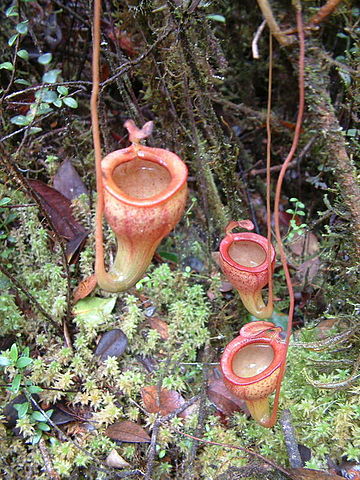 Most species are restricted to very small ranges, including some only found on individual mountains. These limited distributions and the inaccessibility of the regions often means some species go decades without being rediscovered in the wild (e.g. N. deaniana, which was rediscovered 100 years after its initial discovery). About 10 species have population distributions larger than a single island or group of smaller islands. Nepenthes mirabilis has the distinction of being the most widely distributed species in the genus, ranging from Indochina and throughout the Malay Archipelago to Australia.
Most species are restricted to very small ranges, including some only found on individual mountains. These limited distributions and the inaccessibility of the regions often means some species go decades without being rediscovered in the wild (e.g. N. deaniana, which was rediscovered 100 years after its initial discovery). About 10 species have population distributions larger than a single island or group of smaller islands. Nepenthes mirabilis has the distinction of being the most widely distributed species in the genus, ranging from Indochina and throughout the Malay Archipelago to Australia.
 Because of the nature of the habitats that Nepenthes species occupy, they are often graded as either lowland or highland species, depending on their altitude above sea level, with 1,200 m (3,937 ft) the rough delineation between lowland and highland. Species growing at lower altitudes require continuously warm climates with little difference between day and night temperatures, whereas highland species thrive when they receive warm days and much cooler nights.
Nepenthes lamii grows at a higher altitude than any other in the genus, up to 3,520 m (11,549 ft).
Because of the nature of the habitats that Nepenthes species occupy, they are often graded as either lowland or highland species, depending on their altitude above sea level, with 1,200 m (3,937 ft) the rough delineation between lowland and highland. Species growing at lower altitudes require continuously warm climates with little difference between day and night temperatures, whereas highland species thrive when they receive warm days and much cooler nights.
Nepenthes lamii grows at a higher altitude than any other in the genus, up to 3,520 m (11,549 ft).
Most Nepenthes species grow in environments that provide high humidity and precipitation and moderate to high light levels. A few species, including N. ampullaria, prefer the dense, shaded forests, but most other species thrive on the margins of tree/shrub communities or clearings. Some species (e.g. N. mirabilis) have been found growing in clear-cut forest areas, roadsides, and disturbed fields. Other species have adapted to growing in savanna-like grass communities.
The soils in which Nepenthes species grow are usually acidic and low in nutrients, being composed of peat, white sand, sandstone, or volcanic soils. Exceptions to these generalities include species that thrive in soils with high heavy metal content (e.g. N. rajah), on sandy beaches in the sea spray zone (e.g. N. albomarginata). Other species grow on inselbergs and as lithophytes, while others, such as N. inermis, can grow as epiphytes with no soil contact.
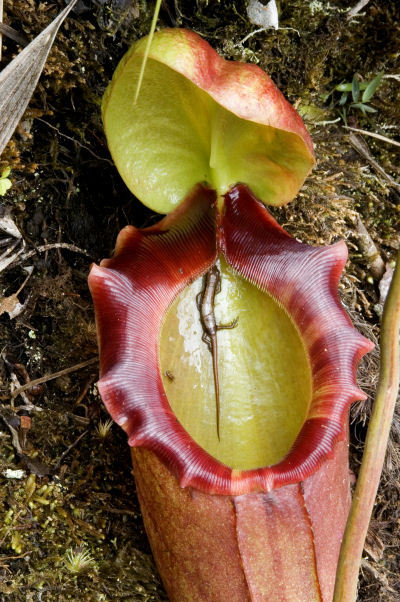 Ecological Relationships
Ecological Relationships
The most obvious interaction between Nepenthes species and their environments, including other organisms, is that of predator and prey. Nepenthes species certainly attract and kill their prey, albeit passively, through active production of attractive colours, sugary nectar, and even sweet scents. From this relationship, the plants primarily gain nitrogen and phosphorus to supplement their nutrient requirements for growth, given these soil nutrients are typically lacking. The most frequent prey is an abundant and diverse group of arthropods, with ants and other insects topping the menu.
Other arthropods found frequently include spiders, scorpions, and centipedes, while snails and frogs are more unusual, but not unheard of. The most uncommon prey for Nepenthes species includes rats found in N. rajah. The composition of prey captured depends on many factors, including location, but can incorporate hundreds of individual insects and many different species.
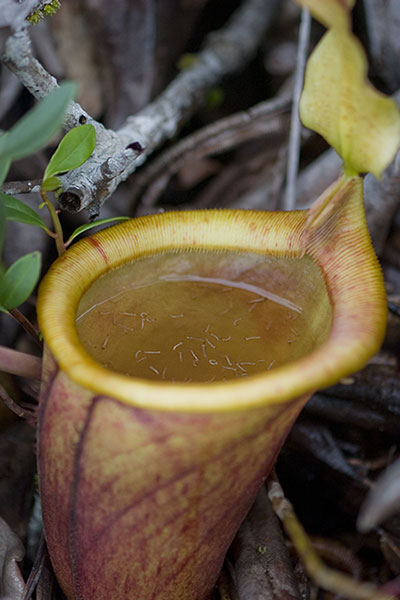 While many Nepenthes species are generalists in what they capture, at least one, N. albomarginata, has specialised and almost exclusively traps termites and produces nearly no nectar. Nepenthes albomarginata gains its name from the ring of white trichomes directly beneath the peristome. These trichomes—or “hairs”—are palatable to termites and will attract them to the pitcher. In the course of collecting the edible trichomes, hundreds or thousands of termites will fall into the pitcher.
While many Nepenthes species are generalists in what they capture, at least one, N. albomarginata, has specialised and almost exclusively traps termites and produces nearly no nectar. Nepenthes albomarginata gains its name from the ring of white trichomes directly beneath the peristome. These trichomes—or “hairs”—are palatable to termites and will attract them to the pitcher. In the course of collecting the edible trichomes, hundreds or thousands of termites will fall into the pitcher.
Symbioses
N. bicalcarata provides space in the hollow tendrils of its upper pitchers for the carpenter ant Camponotus schmitzi to build nests. The ants take larger prey from the pitchers, which may benefit N. bicalcarata by reducing the amount of putrefaction of collected organic matter that could harm the natural community of infaunal species that aid the plant’s digestion.
N. lowii has also formed a dependent relationship, but with vertebrates instead of insects. The pitchers of N. lowii provide a sugary exudate reward on the reflexed pitcher lid (operculum) and a perch for tree shrew species, which have been found eating the exudate and defecating into the pitcher. A 2009 study, which coined the term “tree shrew lavatories”, determined between 57 and 100% of the plant’s foliar nitrogen uptake comes from the faeces of tree shrews.
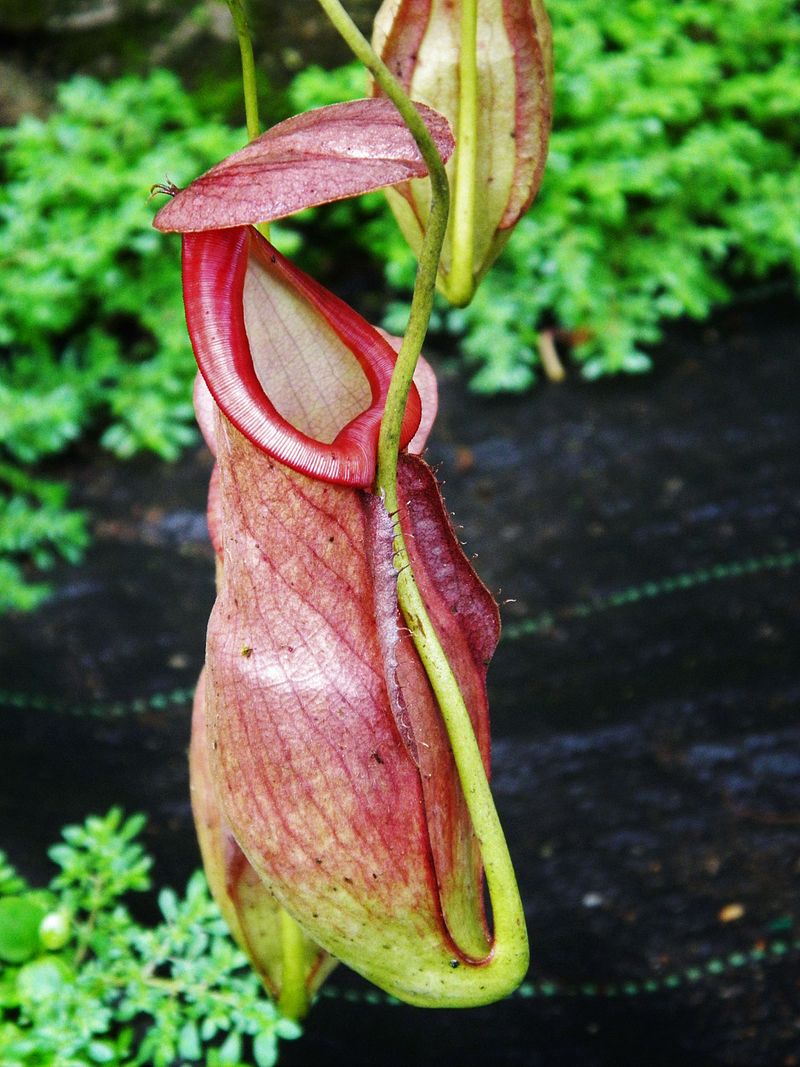 Another study showed the shape and size of the pitcher orifice of N. lowii exactly match the dimensions of a typical tree shrew (Tupaia montana). A similar adaptation was found in N. macrophylla, N. rajah, N. ampullaria, and is also likely to be present in N. ephippiata.
Similarly, N. hemsleyana, which is native to Borneo, has a symbiotic partnership with Hardwicke’s woolly bat. During the day, a bat may roost above the digestive fluid inside the pitcher. While a bat is inside, it may defaecate, and the plant can get nitrogen from the droppings.
Another study showed the shape and size of the pitcher orifice of N. lowii exactly match the dimensions of a typical tree shrew (Tupaia montana). A similar adaptation was found in N. macrophylla, N. rajah, N. ampullaria, and is also likely to be present in N. ephippiata.
Similarly, N. hemsleyana, which is native to Borneo, has a symbiotic partnership with Hardwicke’s woolly bat. During the day, a bat may roost above the digestive fluid inside the pitcher. While a bat is inside, it may defaecate, and the plant can get nitrogen from the droppings.
 Antimicrobial properties
Antimicrobial properties
Nepenthes digestive fluids are sterile before pitchers open and contain secondary metabolites and proteins that act as bactericides and fungicides after the pitcher opens. While the digestive fluid is being produced, the pitcher is not yet open, so there is no chance of microbial contamination. During pitcher development, at least 29 digestive proteins including proteases, chitinases, pathogenesis-related proteins and thaumatin-like proteins are produced in the pitcher fluid. In addition to breaking down prey, these can act as antimicrobial agents. When the pitchers open, the fluid is exposed to bacteria, fungal spores, insects and rain.
Often pitchers have a lid that covers the trap, excepting a few (e.g. N. lowii, N. attenboroughii and N. jamban), preventing rain water from entering. The lid inhibits rainwater from diluting the digestive fluid. Once the bacteria and fungi enter the fluid, secondary metabolites are produced in addition to antimicrobial proteins. Naphthoquinones, a class of secondary metabolite, are commonly produced, and these either kill or inhibit the growth and reproduction of bacteria and fungi. This adaptation could have evolved since Nepenthes plants that could produce secondary metabolites and antimicrobial proteins to kill bacteria and fungi were most likely more fit. Plants that produced antimicrobial compounds could prevent loss of valuable nutrients gained from insects within the pitcher. Since Nepenthes cannot digest certain bacteria and fungi, the bactericides and fungicides allow plants to maximize nutrient uptake.
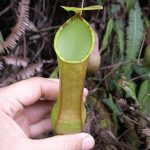

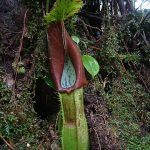
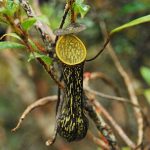

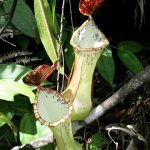
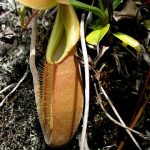
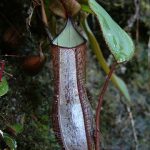
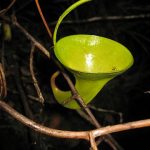

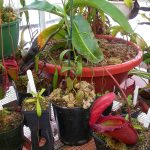
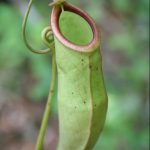
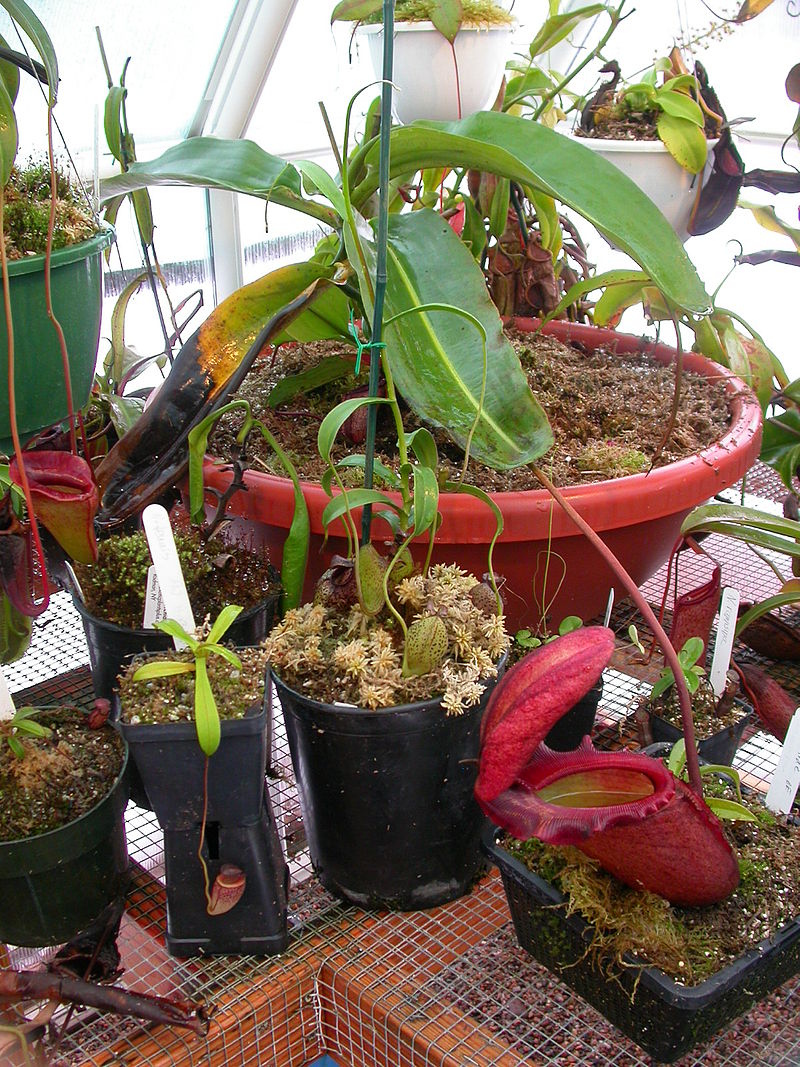 Cultivation
Cultivation
Nepenthes may be cultivated in greenhouses. Easier species include N. alata, N. ventricosa, N. khasiana, and N. sanguinea. These four species are highlanders (N. alata has both lowland and highland forms), some easy lowlander species are N. rafflesiana, N. bicalcarata, N. mirabilis, and N. hirsuta.
Highland forms are those species that grow in habitats generally higher in elevation, and thus exposed to cooler evening temperatures. Lowland forms are those species growing nearer to sea level. Both forms respond best to rainwater (but some tap water works as long as it is flushed monthly with rainwater or water low in dissolved solid and chemicals), bright light (though some species can grow in full sun), a well-drained medium, good air circulation and relatively high humidity, although easier species such as N. alata can adapt to lower humidity environments.
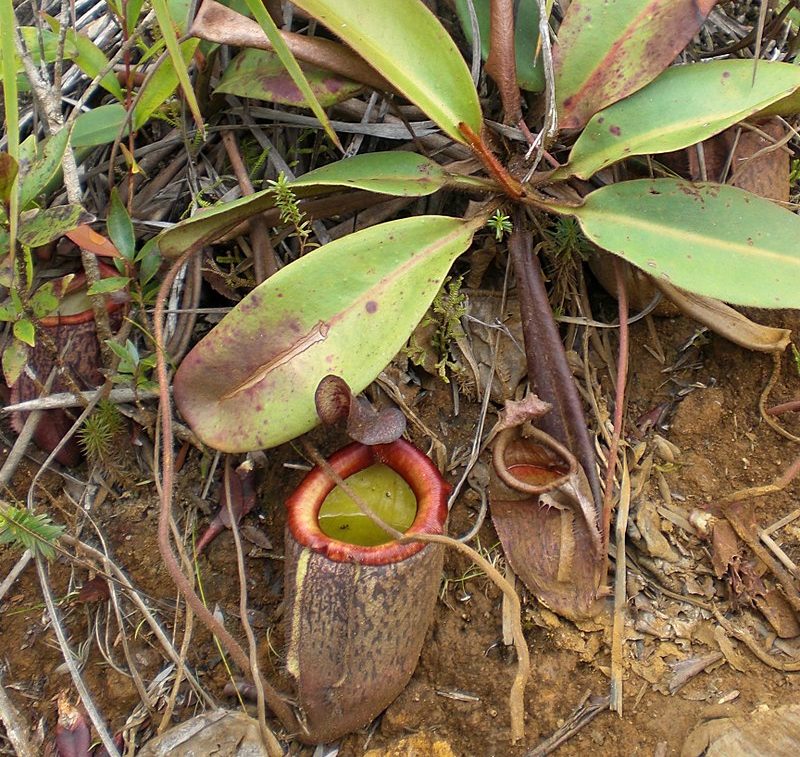 Highland species must have night-time cooling to thrive in the long term. Chemical fertilisers are best used at low strength. Occasional feeding with frozen (thawed before use) crickets may be beneficial. Terrarium culture of smaller plants, such as N. bellii, N. × trichocarpa and N. ampullaria, is possible, but most plants will get too large over time.
Highland species must have night-time cooling to thrive in the long term. Chemical fertilisers are best used at low strength. Occasional feeding with frozen (thawed before use) crickets may be beneficial. Terrarium culture of smaller plants, such as N. bellii, N. × trichocarpa and N. ampullaria, is possible, but most plants will get too large over time.
Plants can be propagated by seed, cuttings, and tissue culture. Seeds are usually sown on damp chopped Sphagnum moss, or on sterile plant tissue culture media once they have been properly disinfected. The seeds generally become nonviable soon after harvesting, so seed are not usually the preferred method of propagation.
A 1:1 mixture of orchid medium with moss or perlite has been used for germination and culture. Seed may take two months to germinate, and two years or more to yield mature plants. Cuttings may be rooted in damp Sphagnum moss in a plastic bag or tank with high humidity and moderate light. They can begin to root in one to two months and start to form pitchers in about six months. Tissue culture is now used commercially and helps reduce collection of wild plants, as well as making many rare species available to hobbyists at reasonable prices. Nepenthes species are considered threatened or endangered plants and all of them are listed in CITES appendices 2, with the exception of N. rajah and N. khasiana which are listed in CITES appendix 1.
